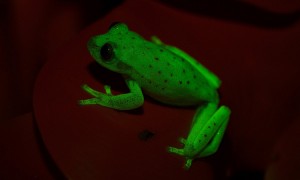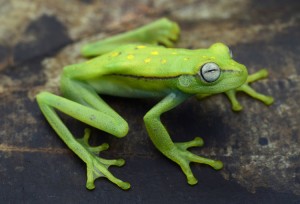First Fluorescent Frog
Friday, March 24th, 2017March 24, 2017
If you are lucky enough to go camping along the banks of the Paraná River in the Argentine Pampas of South America, be sure to carry an ultraviolet (UV) flashlight with you. Among the leaves, vines, and creepy crawlies, you just might find glow-in-the-dark frogs! A couple of weeks ago, a team of researchers from the University of Buenos Aires and Brazil’s University of São Paulo discovered the first fluorescent frog near Santa Fe, a city in northeastern Argentina. Yes, these frogs can create their own light! This first fluorescent frog, the polka dot tree frog, is already well-known and commonly found throughout the Pampas and the nearby Amazon Basin, so it is not a new species. But scientists did not know the amphibians had fluorescent “power” until now.

The one-and-only glow-in-the-dark polka dot tree frog changes color at sunset. Credit: © Carlos Taboada, Bernardino Rivadavia Natural Sciences Museum (Buenos Aires)
The capability to absorb light at short wavelengths and re-emit it at longer wavelengths is called fluorescence. It is uncertain why some animals have this ability, but it may be used to communicate, for camouflage, or to attract a mate. Fluorescence is fairly common in the ocean, where fish, plankton, and even sea turtles can emit their own light. In the desert, scorpions also glow in the dark. But never before has anyone seen a phosphorescent amphibian. Scientists found that the 1.2-inch (3-centimeter) polka dot tree frog’s glowing ability come from a compound found in the lymph and skin glands of its translucent (see-through) body. The fluorescence does not work in complete darkness, but rather at twilight, when the frog’s skin has recently absorbed light, and its color goes from a dull pale green with speckled white, yellow, or reddish spots, to a bright green with dark spots.

A polka dot tree frog (Hypsiboas punctatus) pretends to be just like any other tree frog during the day. Credit: © Patrick K. Campbell, Shutterstock
There are thousands of frog species around the world, and they live on every continent except Antarctica. If you pay attention, you’ll notice that new frog species are discovered fairly often. Their sometimes tiny size and reclusive habits in the remotest of forests make some frogs extremely hard to find. The polka dot tree frog may be the first fluorescent frog known to science, but the ever-evolving natural world is bound to be hiding others in the darkest corners of Earth—just keep your UV light on and your eyes open!


